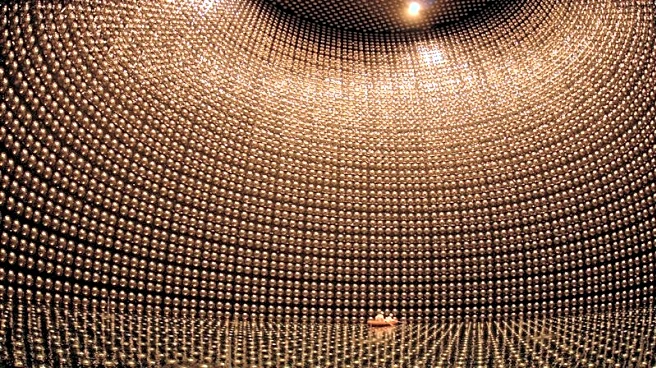What's Happening?
Researchers at the University of York have proposed a novel method for detecting dark matter, suggesting that it might subtly alter the color of light passing through regions filled with it. This challenges
the traditional view that dark matter is completely invisible, interacting only through gravitational forces. The study posits that light could acquire a red or blue tint depending on the type of dark matter it encounters, potentially offering a direct detection method. This concept is based on a network-like model of particle connections, where dark matter might influence light indirectly through intermediaries such as the Higgs boson and top quark. The findings could reshape how telescopes search for cosmic mysteries, providing a new approach to studying the unseen material that constitutes 85% of the Universe.
Why It's Important?
The implications of this research are significant for the field of astrophysics and the broader scientific community. If dark matter can indeed be detected through optical means, it would revolutionize current understanding and methodologies in cosmic research. This could lead to more efficient and targeted efforts in the search for dark matter, potentially saving time and resources. The ability to detect dark matter directly would deepen scientific understanding of the Universe's composition and the forces that hold it together. It could also influence the design of future telescopes, integrating these findings to enhance their capabilities in exploring cosmic phenomena.
What's Next?
The study suggests that upcoming experiments could test these indirect interactions, allowing scientists to refine dark matter models. Future telescopes might incorporate these findings to improve detection methods. The research team emphasizes the importance of integrating these insights into the design of next-generation telescopes, potentially simplifying the search for dark matter. Confirming these results could provide a new approach to detecting dark matter and deepen understanding of the Universe's structure.
Beyond the Headlines
This research introduces a paradigm shift in the perception of dark matter, suggesting it might not be entirely invisible. The ethical and scientific implications of this discovery could lead to a reevaluation of existing theories and models in physics. It highlights the importance of interdisciplinary approaches in solving complex cosmic mysteries, potentially influencing future research directions in astrophysics.












